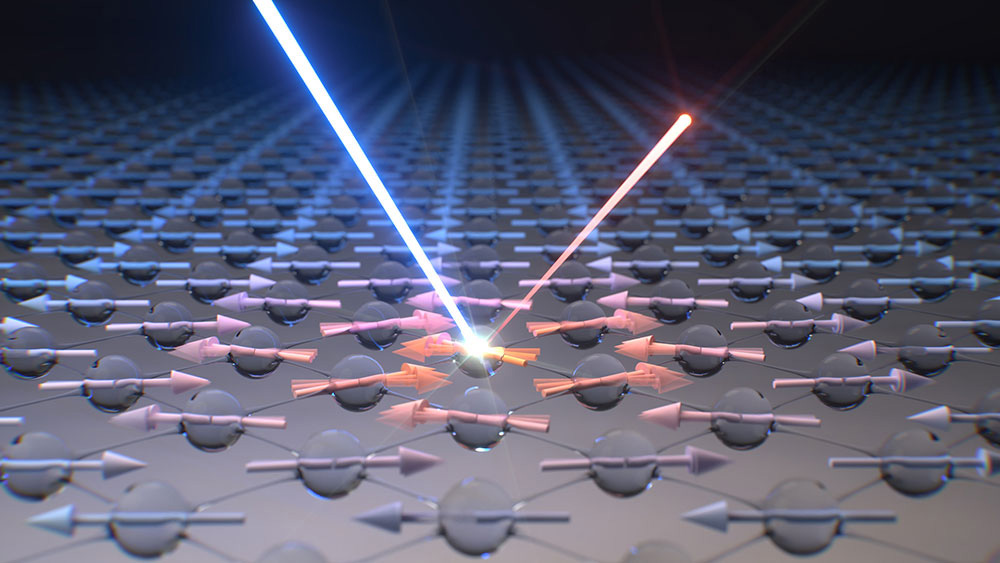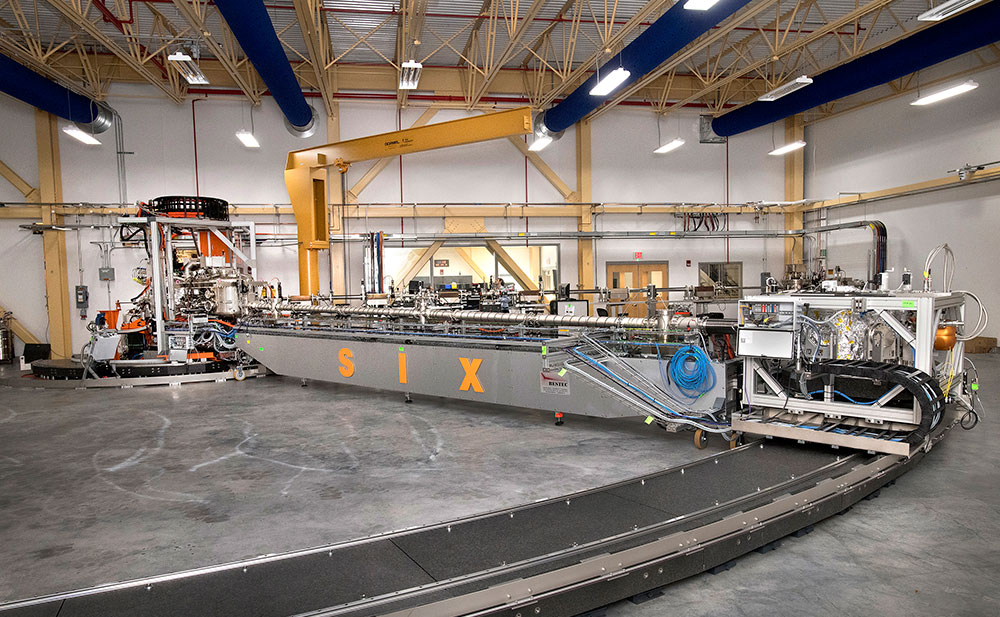
Brad Baxley
Researchers use a technique called resonant inelastic X-ray scattering, or RIXS, to study the electronic behavior of quantum materials. The image above illustrates an ultrabright X-ray striking a quantum material’s electrons (gray circles) and scattering off the sample. In this example, the X-ray’s energy change will provide insight into an electron property called spin, represented by the arrows.
|
ADVERTISEMENT |
From computer chips to image sensors in cameras, today’s technology is overwhelmingly based on a semiconductor called silicon. This technology has been shrinking for decades—think of early room-sized computers compared to today’s desktops—but physical limitations will soon prevent further improvement.
That’s why scientists and engineers are preparing for a new generation of technology, one based on quantum mechanics.
The electrons in so-called “quantum materials” behave differently than those in silicon, enabling more complex behaviors, like magnetism and superconductivity, that are useful for future quantum technologies.
“Our piece of the puzzle is understanding how these materials function as a prerequisite for using them in engineering devices,” says Mark Dean, a physicist at the U.S. Department of Energy’s Brookhaven National Laboratory and leader of the Dynamics and Control Group in Brookhaven’s Condensed Matter Physics and Materials Science Department.
Dean characterizes quantum materials using RIXS, which is particularly suited to probing samples as thin as one atomic layer, and material states that change very rapidly. With recent technological developments, researchers expect this technique to enable studies that were unthinkable only five years ago.
This progress gave Dean and three colleagues—Matteo Mitrano, Steven Johnston, and Young-June Kim—the impetus to chart where the field is going as a whole. So, they summarized the technique’s state of the art and how they expect the field to progress in a perspective paper recently published in Physical Review X.
“As Physical Review X only publishes perspective papers about once every two years, they are quite high-profile,” says Mitrano, a physicist at Harvard University and first author on the article. Physical Review X is the American Physical Society’s highest impact journal.
“We wanted to write something that could inspire our colleagues,” Mitrano says. “That spirit led to this paper that is very forward-looking.”
 Perspective paper co-authors (left to right): Matteo Mitrano, Steven Johnston, Young-June Kim, and Mark Dean. Images: Stephanie Mitchell/Harvard University; University of Tennessee; Karyn Gorra/University of Toronto; Alex Reben/Brookhaven National Laboratory
Perspective paper co-authors (left to right): Matteo Mitrano, Steven Johnston, Young-June Kim, and Mark Dean. Images: Stephanie Mitchell/Harvard University; University of Tennessee; Karyn Gorra/University of Toronto; Alex Reben/Brookhaven National Laboratory
RIXS 101
In RIXS, researchers excite or disturb materials by zapping them with ultrabright X-rays. This interaction alters both the X-rays and the material, but researchers can use spectrometers to precisely measure changes in X-ray energy and momentum. From these measurements, the researchers can infer the energy and momentum changes that occurred within the material, as well as how the material’s electrons interacted with each other.
“It’s like a guitar string,” says Johnston, Bains Professor of Physics and Astronomy at the University of Tennessee. “To play the instrument, a musician presses fingers down at different frets, effectively changing the length of the strings. Based on the frequency of the sound that comes out of the guitar, you can figure out the length of the guitar string.”
While other X-ray imaging techniques yield hints about electron behavior, RIXS is unique in that it clearly captures the microscopic fluctuations and excitations of electrons, “allowing experimentalists to look into places that were conventionally forbidden,” says Kim, a physics professor at the University of Toronto and former Goldhaber Fellow at Brookhaven Lab.
This is because, with the proper equipment, RIXS can be used to measure extremely small changes in X-ray energy.
“We have one of the best places in the world for doing RIXS,” Dean says, referring to the Soft Inelastic X-ray Scattering (SIX) beamline at the National Synchrotron Light Source II (NSLS-II), Energy’s Office of Science user facility at Brookhaven Lab.
The SIX beamline is a cutting-edge experimental station that’s resistant to vibration and particularly capable of capturing small energy changes at a high resolution, and it has already enabled several successful RIXS studies. For example, Mitrano, Johnston, and Dean have collaborated with SIX beamline scientists Valentina Bisogni and Jonathan Pelliciari to uncover details about the formation and behavior of mobile, microscopic, particle-like objects called excitons.
 The Soft Inelastic X-ray Scattering (SIX) beamline at the National Synchrotron Light Source II. Image: Roger Stoutenburgh/Brookhaven National Laboratory
The Soft Inelastic X-ray Scattering (SIX) beamline at the National Synchrotron Light Source II. Image: Roger Stoutenburgh/Brookhaven National Laboratory
Exploring quantum materials with RIXS
Researchers have also used RIXS to observe the electronic behavior of quantum materials, providing key insights into how these materials are useful for future technologies. But some of the most exciting applications of RIXS, explored in the perspective paper, are yet to come.
For example, the researchers plan to use RIXS to directly prove the presence of quantum entanglement, a spooky property in which two or more particles are linked, even if separated by significant distances. Though entanglement is fundamental to quantum information science—and a key feature of future quantum technology — the property remains elusive.
“Quantum has been used as a buzzword over the last decade or so, but we need to be more descriptive about what qualifies a material as quantum,” says Mitrano. “So, we’ve embarked on this journey to investigate whether we can detect entanglement and harness its properties.”
Though Dean expects SIX to remain instrumental in the exploration of quantum materials, other X-ray sources, like the Linac Coherent Light Source (LCLS) at Energy’s SLAC National Accelerator Laboratory, are enabling ultrafast measurements with RIXS.
“We can use a laser pulse, for example, to manipulate the quantum state of the material, and then we can observe these new states with RIXS,” Dean says. These quantum states only last for picoseconds—the equivalent of trillionths of a second—which is why the measurements need to be ultrafast. But these to-be-discovered states of matter could exhibit novel properties that will unlock new technological capabilities.
“RIXS is giving us a new playground to understand how light can be used to manipulate materials and their properties on a microscopic scale,” says Kim.
Quantum materials made of several two-dimensional layers, like those fabricated by the Quantum Material Press at the Center for Functional Nanomaterials (CFN), also exhibit new and technologically relevant properties that researchers are eager to explore with RIXS. CFN is an Energy Office of Science user facility at Brookhaven Lab.
Despite the technique’s proven success, “the way that X-rays interact with materials is quite complicated,” Johnston says. This makes RIXS often challenging to interpret. But close collaborations between theorists and experimentalists have benefited the field significantly.
Notably, the technology behind RIXS continues to advance rapidly, positioning the technique to make even more effective contributions to the understanding of quantum materials that could make up future computers, sensors, communications systems, and much more.
Published March 3, 2025, by Brookhaven National Laboratory.
Add new comment